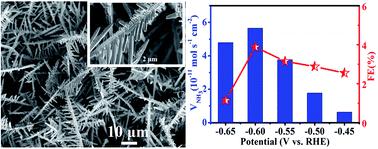当前位置:
X-MOL 学术
›
Sustain. Energy Fuels
›
论文详情
Our official English website, www.x-mol.net, welcomes your feedback! (Note: you will need to create a separate account there.)
Sn dendrites for electrocatalytic N2 reduction to NH3 under ambient conditions
Sustainable Energy & Fuels ( IF 5.6 ) Pub Date : 2020-06-30 , DOI: 10.1039/d0se00828a Xu Lv 1, 2, 3, 4 , Fengyi Wang 1, 2, 3, 4 , Juan Du 1, 2, 3, 4 , Qian Liu 4, 5, 6, 7 , Yongsong Luo 4, 5, 6, 7 , Siyu Lu 4, 8, 9, 10 , Guang Chen 11, 12, 13, 14, 15 , Shuyan Gao 4, 16, 17, 18 , Baozhan Zheng 1, 2, 3, 4 , Xuping Sun 4, 5, 6, 7
Sustainable Energy & Fuels ( IF 5.6 ) Pub Date : 2020-06-30 , DOI: 10.1039/d0se00828a Xu Lv 1, 2, 3, 4 , Fengyi Wang 1, 2, 3, 4 , Juan Du 1, 2, 3, 4 , Qian Liu 4, 5, 6, 7 , Yongsong Luo 4, 5, 6, 7 , Siyu Lu 4, 8, 9, 10 , Guang Chen 11, 12, 13, 14, 15 , Shuyan Gao 4, 16, 17, 18 , Baozhan Zheng 1, 2, 3, 4 , Xuping Sun 4, 5, 6, 7
Affiliation

|
Industrial-scale synthesis of NH3 mainly relies on the energy-intensive Haber–Bosch technology, which not only needs harsh conditions but also produces a large amount of CO2. Electrochemical N2 reduction is regarded as an environmentally friendly method for artificial N2-to-NH3 conversion, but needs efficient catalysts for the N2 reduction reaction (NRR). Here, we report that Sn dendrites on Sn foil act as a non-noble-metal electrocatalyst for the electrochemical NRR under ambient conditions. This electrocatalyst affords an NH3 yield of 5.66 × 10−11 mol s−1 cm−2 and a Faraday efficiency of 3.67% at −0.60 V versus the reversible hydrogen electrode in 0.1 M PBS (pH = 7.0), with high electrochemical durability.
中文翻译:

锡枝晶在环境条件下用于将N2电催化还原为NH3
工业规模的NH 3合成主要依靠高能耗的Haber-Bosch技术,该技术不仅需要苛刻的条件,而且还会产生大量的CO 2。电化学N 2还原被认为是将N 2人工转化为NH 3的一种环境友好的方法,但是需要用于N 2还原反应(NRR)的高效催化剂。在这里,我们报道在环境条件下,Sn箔上的Sn树枝状晶体作为电化学NRR的非贵金属电催化剂。该电催化剂的NH 3收率为5.66×10 -11 mol s -1 cm -2与在0.1 M PBS(pH = 7.0)中的可逆氢电极相比,在-0.60 V时法拉第效率为3.67%。
更新日期:2020-08-25
中文翻译:

锡枝晶在环境条件下用于将N2电催化还原为NH3
工业规模的NH 3合成主要依靠高能耗的Haber-Bosch技术,该技术不仅需要苛刻的条件,而且还会产生大量的CO 2。电化学N 2还原被认为是将N 2人工转化为NH 3的一种环境友好的方法,但是需要用于N 2还原反应(NRR)的高效催化剂。在这里,我们报道在环境条件下,Sn箔上的Sn树枝状晶体作为电化学NRR的非贵金属电催化剂。该电催化剂的NH 3收率为5.66×10 -11 mol s -1 cm -2与在0.1 M PBS(pH = 7.0)中的可逆氢电极相比,在-0.60 V时法拉第效率为3.67%。



























 京公网安备 11010802027423号
京公网安备 11010802027423号